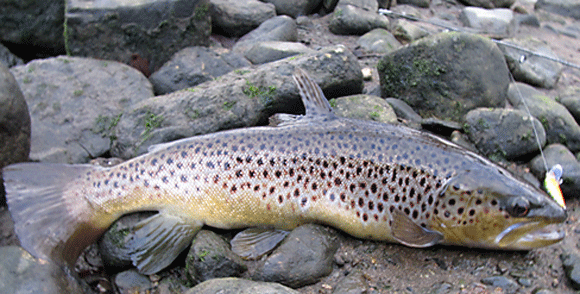Changes coming to sea-run trout program
By Ron Merly
State fisheries biologist Tim Wildman has not been happy with the number of annual returns of sea-run brown trout that are currently released into Connecticut estuaries. Seeforellen browns from Germany, which are indigenous to their lakes, are raised at Connecticut’s Kensington Hatchery and released into some lakes and reservoirs, but are also used for stocking sea-run brown trout as well. These fish do not have a dianadromous lineage: In other words, they do not run out to sea and return, they live in lakes.
Wildman resurrected the sea-run brown trout program in Connecticut in 2000 when he saw trout being destroyed as too many were being raised to release into the state’s waters. He took the excess fish and began releasing them into several estuaries around the state. (See the Flyfisher’s Guide to Connecticut for more info on where to find them).
After approximately 10 years of light returns, Wildman began to search European countries for natural strains of sea-run brown trout. There are many, however the standards for importing fish into this country are very strict so that diseases are not brought into our waters. After years of research and the convincing of his bosses, he has successfully imported a natural sea-run brown trout strain from a country that borders the Baltic Sea. Wildman asked that I not disclose the country so I will not.
This exciting change will begin to occur this year (2014), so returns should be seen in 2 to 3 years. These fish have a vast range that naturally covers an area about ths size of Long Island Sound. This strain of brown trout should return at an average of 6 to 8 pounds, but some grow as large as 15 pounds in the Baltic. Wildman hopes to establish significant returns of the browns and would like to see Connecticut become a sea-run trout fishing destination. Tim also said that not one fish was lost during the importation process so they appear to be a very hearty strain.
Lets keep our fingers crossed!! Thanks to Tim for all of his effort and we wish him well in this endeavor.

Why use brown trout, a European import, rather than native Atlantic salmon and brook trout?
Brian, great question. Unfortunately the answer is a long story – so let me try to keep it short. In simple terms, century long industrial and residential development leading to increasing water withdrawals and thermal pollution (among other things) make most brook environments along the coast unfavorable to natural brook trout reproduction. Brown trout are slightly more robust and can stand higher water temperatures, so they are much more compatible with environmental conditions along the CT coast.
Atlantic salmon restoration has basically invested hundreds of millions of dollars into trying to get these fish re-established. Federal and state attempts to continue have more or less come to a stop due to a lack of success – however some private groups continue to try – for instance the Downeast Salmon Federation is hard at work trying to reinvent salmon restoration.
Is the failure of federal and state salmon restoration due to a lack of continued funding or a fundamental flaw in the way they were doing things ? -We may never know, but it is a basic truth that a century plus of heavy industrial and residential development like found in coastal areas tend to disfavor native cold-water-dependent fish reproduction because there just isn’t enough cold water to go around. And with droughts and continued increase in need for water and additional development, things just aren’t looking favorable – however Tim Wildman and the state of CT are to be applauded for taking the initiative in trying to get this special brown trout strain to work – after all, there is a lot of habitat that sea-run brown trout can thrive in there on the coast. And there is always a chance that wild brookies might turn up in a coastal access stream that has survived. If you are looking for them, pay special attention to federal or state parks that protect the lands around coastal access streams.
Good luck!
Having fished for and caught numerous atlantics starting in 1973 on the Machias, the Spey in Scotland, the Narraguagus and the Merrimachi I share your concerns regarding restoration of this great fish. I do believe, funding aside, there may be a fundamental flaw in our methods.
For many years I have been interested in sea run browns and caught 3 one day on the Orland River near Bucksport, Maine.
They are a great fish and I hope you succeed
we need to set up small hatcheries on the brooks that empower sea run browns so they can get the scent of the water the are going to be set free